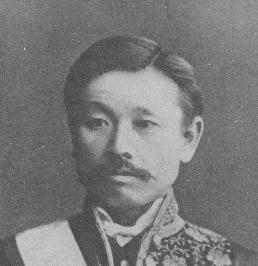Inoue Kaoru
Count Inoue Kaoru (井上 馨 Inoue Kaoru), (16 January 1836 - 1 September 1915) was a Japanese statesman and a member of the Meiji oligarchy that ruled Japan during the Meiji period (1868–1912).
Early Years
Born Yakichi (勇吉) to a lower-ranked samurai family in Hagi (present day Yamaguchi Prefecture), Inoue attended the Han school with his brother Ikutarō (幾太郎). He was a close boyhood friend of Ito Hirobumi who later became Japan's first prime minister, and he played an active part in the sonno joi movement. In 1858, he studied Dutch Learning, gunnery and swordsmanship in Edo.
He was a leader of the antiforeigner movement in his native Chōshū. Desiring to rid Japan of foreigners, he and Takasugi Shinsaku set fire to the British legation in Edo in January 1863.
Recognizing Japan's need to learn from the western powers, he joined the Chōshū Five and was sent to study in London in 1863. When he returned with Ito Hirobumi, he unsuccessfully tried to prevent war (the Battle of Shimonoseki) between the Chōshū and the western naval powers over the closing of the Straits of Shimonoseki to foreign shipping. Later, he played a key role in the formation of the Satcho Alliance against the Tokugawa bakufu.
Statesman in the Meiji government
After the Meiji restoration, Inoue served in several important government positions until being appointed Vice Minister of Finance in 1871. He was influential in reorganizing government finances on modern lines, especially in the reform of the land tax system, termination of government stipends to the ex-samurai and former aristocracy and for promoting the industrialization of Japan. These measures created many political enemies, and Inoue was forced to resign in May 1873.
In 1876, he was involved in the conclusion of the Japan-Korea Treaty of Amity as vice-ambassador extraordinary and plenipotentiary. Closely linked to business circles, including Mitsui, he was also involved in the railway business.
He returned to government as Minister of Public Works in 1878 and Minster of Foreign Affairs in 1879.
As foreign minister in the first Ito administration, his failure to negotiate a revision of the unequal treaties and his unpopular Westernizing influence forced him to resign in 1887. Later he served as Minister of Agriculture and Commerce in the Kuroda administration, as Home Minister in the second Ito administration and again as Finance Minister in the 3rd Ito administration.
From 1901, he served as most senior of the genro, and considered himself the government's foremost advisor on financial affairs.
When he served as diplomat to Chosun dynasty(Korea), he was deeply involved in killing Empress Myeongseong in 1895.
Reference and further reading
- Akamatsu, Paul. Meiji 1868: Revolution and Counter-Revolution in Japan. Trans. Miriam Kochan. New York: Harper & Row, 1972.
- Beasley, W. G. The Meiji Restoration. Stanford: Stanford University Press, 1972.
- Beasley, W. G. The Rise of Modern Japan: Political, Economic and Social Change Since 1850. St. Martin's Press, New York 1995.
- Craig, Albert M. Chōshū in the Meiji Restoration. Cambridge: Harvard University Press, 1961.
- Jansen, Marius B. and Gilbert Rozman, eds. Japan in Transition: From Tokugawa to Meiji. Princeton: Princeton University Press, 1986.
External links
ja:井上馨 ru:Каору, Инуэ
Credits
New World Encyclopedia writers and editors rewrote and completed the Wikipedia article in accordance with New World Encyclopedia standards. This article abides by terms of the Creative Commons CC-by-sa 3.0 License (CC-by-sa), which may be used and disseminated with proper attribution. Credit is due under the terms of this license that can reference both the New World Encyclopedia contributors and the selfless volunteer contributors of the Wikimedia Foundation. To cite this article click here for a list of acceptable citing formats.The history of earlier contributions by wikipedians is accessible to researchers here:
The history of this article since it was imported to New World Encyclopedia:
Note: Some restrictions may apply to use of individual images which are separately licensed.
